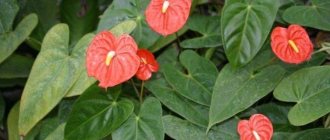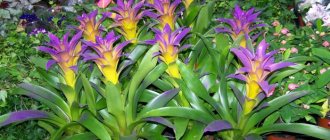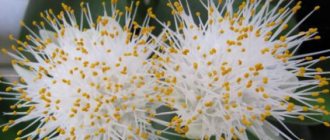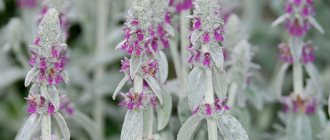Callas are very noble and delicate plants with a unique flower shape. Their homeland is considered to be South Africa. But at the same time, they grow well in our climate not only indoors, but also in garden plots.
Callas can be grown both at home and in the garden
They are popularly called “wedding flowers” or whitewing. Translated from Greek, their name means “beautiful.” It is believed that callas, which bloom regularly, bring happiness, prosperity to the house and bring harmony to family life. Nowadays, many people grow flowers similar to calla lilies. Therefore, it is important to know what they are called and how to distinguish them from each other.
We study varieties of calla lilies - flowers for the bride
Calla lilies are a popular ornamental plant in gardens, greenhouses and potted plants. Callas belong to the genus Zantedeschia, perennial herbs of the araceae family. The popular name of the flower is whitewing. This apt word accurately reflects the appearance of the culture - the large wide petal-veil is most often white and looks like a bird’s wing. The flower comes from equatorial and southern Africa. There it grows in swampy places.
Folk names
In Russia, calla lilies also have a number of popular names, such as:
In the Urals calla lilies are called Bogoroditsyn to help. This is due to its use in folk medicine. Healers use it in many cases, for example:
- to reduce pain;
- with rheumatism;
- to relieve inflammation;
- as a laxative.
On a note! In nature, calla lilies are an endangered plant that is heavily protected in many European countries. In Russia and Ukraine, it is listed in the Red Books of several territories and regions.
General description of calla lilies
Calla, or zantedeschia, is a perennial herbaceous plant up to 2.5 meters high.
The leaves are wide, basal, dark green. Some varieties have leaves covered with white spots. The inflorescence is a yellow spadix on a long peduncle. The flower cover is large, funnel-shaped, white, pink or yellow. Callas are grown in greenhouses and are common in indoor floriculture. Many varieties are suitable for cutting, as they can last in a bouquet for up to a month.
Callas are considered poisonous plants due to their high calcium oxalate content.
The entire plant is poisonous. If calla lily juice gets on the mucous membranes, pain and irritation occur, swelling and a subsequent severe allergic reaction are possible. Contact dermatitis may appear on the skin from the juice of the flower. You should take care of it very carefully, avoiding getting the juice on your skin.
Callas can be propagated by seeds, but most often this is done vegetatively - by dividing the root.
Calla lilies require a period of rest for regular flowering. It lasts from two to six months.
During this period, colored species shed their leaves and completely stop growing, while white callas do not lose their decorative appearance, but stop developing. During the dormant period, colored varieties are stored in a cool place in the form of a dormant tuber, and white varieties are limited in watering.
The following types of callas are common in indoor floriculture:
- Elliot's calla lily;
- Calla Remani;
- Picasso calla;
- Ethiopian calla.
Photos of calla lilies amaze with their variety of shapes and colors. Among them there are snow-white specimens, yellow, red, purple and almost black. Two-color varieties are especially beautiful, when the flower has different shades at the base and edges.
The toxicity of the azure flower
All parts of delphinium contain alkaloids, which determine its poisonous properties. The roots and fruits are especially poisonous. The composition of the poison is similar to that of curare.
Getting delphinium into the body is fraught with:
- Depression of the central nervous system.
- Damage to the gastrointestinal tract.
- Negative effects on the cardiovascular system.
- Vomiting, excessive saliva.
- Convulsions in the whole body or in certain parts of it.
- General muscle weakness.
- Death due to paralysis of the respiratory system.
Important! The most poisonous species are: Larkspur and cultivated garden plants.
Apply the flower as follows:
- Dyes for wool are made from some species.
- Delphinium is used to destroy harmful insects.
- It is used for medical purposes.
- Used by traditional healers.
Calla Elliott "Zantedeschia elliottiana"
Calla Elliott has large leaves with white spots and flowers of two shades. The plant is a tuberous plant and is best propagated vegetatively. The variety loves good care - a lot of light, warmth, frequent watering.
The most famous varieties of callas:
- “Vermeer” is highly decorative. The leaves are carved, wavy along the edges, covered with white specks. The stem has a burgundy calla flower, gradually turning white closer to the edges.
- “Yellow corner” - the green stem gradually changes color to yellowish. The cover of the flower is soft yellow, sunny in color. The variety looks great with bright speckled leaves.
- "Black-Eyed Beauty" - a wide light yellow petal with a deep purple center and a corn-yellow stamen. The leaves are dark, strewn with large white spots of irregular shape.
Calla rehmannii
Calla Remani is a low-growing species. Plants reach a height of no more than half a meter. It has narrow green leaves that are shed in the winter. Propagated by tubers, popular in indoor floriculture.
Known varieties:
- “Evening” is the name given to a variety of calla lilies with dark purple, almost black flowers.
- “Indian Summer” is an unusual and rare variety of red calla lily with a garnet hue.
- “Chameleon” fully lives up to its name - the flowers shine in all shades of peach and golden tones. Dark green leaves are covered with white specks.
- “Picasso” is a variety of calla lilies 35-45 cm high. Large burgundy flowers with a light border bloom in July-September and bloom for up to a month and a half.
- Black Forest - this variety has large candle-shaped flowers of a burgundy-violet hue.
- "Anneke" - beautiful funnel-shaped flowers in a pink-violet hue.
Ethiopian calla (Zantedeschia aethiopica)
Calla Ethiopian is the largest variety of Zantedeschia for growing indoors. This species has large heart-shaped leaves and funnel-shaped inflorescences. During the dormant period, the foliage remains bright green, which increases the decorative appearance of the species.
The most famous varieties of Ethiopian calla lilies include:
- “Green Goddess” is a variety with white-green flowers and a short lemon-colored stamen.
- “Childsiana” - the variety blooms profusely with snow-white flowers with an orange center.
- “Amethyst” is a variety of purple calla lilies that are distinguished by their considerable height and delicate aroma.
- “Pearl” is a tall variety with light green leaves, the flowers are large, white, fragrant, with a greenish tint on the outside. Suitable for bouquets.
- "Albomaculata" - a large white flower with a candle shape and a light vanilla aroma.
- "Captain Chelsea" is a beautiful two-color variety. The bedspread is burgundy with a golden border. The leaves are dark green with silver dots.
- "Little Gem" - calla has white flowers of the original appearance. A flower that has not fully blossomed has a petal that curls like a funnel, with a bright yellow stamen in the middle. At the edge of the petal there is a greenish outgrowth-claw.
Varieties of indoor plants
All varieties of calla lilies are divided into groups: white and colored.
There are 5 main types of calligraphy:
- Ethiopian: a heat-loving species with tall shoots up to 80 cm in height and large fleshy leaves, white spathes with a yellow base. The most popular variety of calligraphy here is called “Green Goddess”. This flower is often used by florists to create wedding bouquets.
- Elliott: medium-sized plant with heart-shaped leaves, flowers are contrastingly colored: the bases of the bracts are yellow-green, the tops are lemon or cream. Flowers of this variety love sunlight and are best grown on open windowsills.
- Remanna: a miniature variety about 30 cm high, the leaves are covered with contrasting light spots, the bracts are bright pink or variegated. From these flowers, variegated hybrid varieties from pale pink to dark lilac are bred.
- Amethyst: A showy variety with large, shiny leaves and funnel-shaped bracts in shades of blue, blue or maroon.
- Swamp calla: the plant is extremely poisonous, grows quickly and consumes everything around it. This species is distinguished by a white flower with a green cylindrical spadix that looks like a cactus.
How to plant calla lilies correctly
Purchased tubers should first be kept in potassium permanganate diluted until pink, and then placed for a couple of hours in a solution of the Kornevin stimulant or any other. The plant requires a fairly large volume of soil - about 2.5 liters per tuber. Drainage is poured into the bottom of the pot, then nutrient soil. The calla tuber is smooth at the bottom and has small protuberances at the top. The tuber should be placed with the smooth side down in moist soil.
The planting should be shallow, the tuber is only covered with a layer of soil no more than 1-2 cm. Otherwise, there is a high risk of root rotting.
Immediately after planting, calla lilies are not watered; the pot is left in a warm place without drafts. In the future, calla flowers need regular watering. The plant also needs to be fed with complex flower fertilizer.
Video selection of varieties and types of calla lilies
Callas are very noble and delicate plants with a unique flower shape. Their homeland is considered to be South Africa. But at the same time, they grow well in our climate not only indoors, but also in garden plots.
Callas can be grown both at home and in the garden
They are popularly called “wedding flowers” or whitewing. Translated from Greek, their name means “beautiful.” It is believed that callas, which bloom regularly, bring happiness, prosperity to the house and bring harmony to family life. Nowadays, many people grow flowers similar to calla lilies. Therefore, it is important to know what they are called and how to distinguish them from each other.
Room temperature
Growing calla lilies in a pot is a simple process. Of course, if you follow certain rules. Do not forget that callas usually grow in southern latitudes, where temperatures are constantly high. These plants are very difficult to tolerate when this indicator drops to 8 °C. Therefore, it is worth keeping calla lilies on the balcony only in warm weather. In winter, the plant should be moved to a room where heating devices are installed. The most favorable temperature for the growth of calla lilies is from 20 to 25 °C.
Description of callas
Callas (Calla) belong to the perennials of the Araceae family. Depending on the type, they can be bulbous or have a rhizome. The shiny, bright green foliage reaches 4 to 15 centimeters in length and 5 to 11 centimeters in width. They are arrow-shaped and may contain white or yellow spots on the outer surface. As a rule, they grow in the form of a basal rosette. Calla flowers have long petioles and a unique structure.
The calla lily inflorescence consists of a yellow spadix and a bract that wraps it in the form of a funnel, like a blanket. It can have a wide variety of colors.
The most popular species grown indoors and in gardens include Ethiopian calla, Remann's calla, and Eliott's calla.
Overview of species
Indoor plants with white flowers are quite numerous and varied. They differ in both appearance and care requirements, but they are united by the white color of their buds.
Azalea
At home, this evergreen shrub grows no higher than 50 cm. Thanks to its lush and long-lasting flowering, the plant has gained extreme popularity. Large azalea buds are simple and double, the leaves are lanceolate, densely pubescent on the reverse side and located on branched shoots. Two varieties are most suitable for home cultivation: Melina (Japanese) and Stella Maris (Indian).
- The Japanese one has a more compact size and a highly decorative appearance; the entire bush is densely strewn with small buds. They can grow either singly or in inflorescences.
- Indian has dark green oval leaf blades and rather large buds. The central petals are strewn with crimson splashes. Flowers can be of different types: simple, double or corrugated.
Gardenia
The evergreen plant can grow either as a compact bush or as a tiny tree. In an apartment, the flower reaches a maximum height of 70-100 cm. Dense small leaves have a glossy surface with pronounced venation and grow in 2 or 3 pieces. The flowers are tubular, with a pronounced pleasant aroma. The most popular variety is the jasmine gardenia.
Large white-cream buds smell strongly of jasmine and form corymbose inflorescences of 4-6 pieces.
The plant belongs to vines, so it needs support. The leaf blades are oval in shape, at first they have a glossy surface and then become matte. The buds are not particularly large, but have an unusual star-shaped shape and form small inflorescences. The flowers are mainly white, but in the middle they acquire red or crimson shades. The following varieties of hoya are suitable for growing indoors: green, beautiful, motoskei.
Spathiphyllum
This striking representative of the aroids is distinguished by a very impressive appearance and the absence of pronounced shoots, very similar to calla lilies. Elongated leaf blades grow almost from the root. The flowers also have a rather unusual appearance: on the flower arrow there is a yellow spadix, wrapped in a white blanket of wide petals. The plant has many varieties, both tall and dwarf.
Among them the most famous are: “Abundantly Flowering”, “Picasso”, “Chopin”, “Sensation”, “Cannoleaf”.
White orchid
The plant is distinguished by a thick stem on which large buds grow. White flowers are rare; most often the petals have an edging or inclusions of a different color. The most popular varieties with white petals include the following:
- “Royal” is distinguished by large flowers, about 15 cm in diameter;
- "Vanda" is characterized by long flowering and a pleasant caramel scent of small flowers;
- “Butterfly” is distinguished by unusual petals, shaped like insect wings;
- "Heron" has flowers that resemble a bird in flight.
Red callas: photo and description
Red callas are flowers of passion. Symbols of love and attraction are a wonderful gift for the one you love. Elegant, sophisticated, they have some kind of attractiveness that makes you look without taking your eyes off, both in a bouquet and standing in a vase at home. They are the perfect creation of nature, the personification of everything chic and attractive! Even in the photo, red calla lilies amaze your imagination with their elegance.
- Kingdom: plants.
- Genus: calla.
- Type: angiosperms.
- Order: Alismatae.
- Class: dicotyledonous.
- Family: araceae.
- Homeland: South Africa. The flower was introduced to America and Europe in the mid-19th century.
- Height: 0.4-1 meter.
- Leaves: dark green, heart-shaped.
- Flowering period: until mid-summer.
- Dormant period: storing tubers in a cool place (dug up).
Bulbs
Let's figure out how to plant calla lilies in a pot and grow them from a bulb. First of all, using such material is the easiest method for growing such plants. Callas are very easily propagated by roots and bulbs. The main thing is to create optimal conditions for their growth.
For those who don't know what a bulb is, it's where a new plant begins to grow. It's not really a root. But in its structure, the calla bulb is very similar to it. To be more precise, it is a thick and fairly large shoot of the main root, from which young shoots subsequently appear.
As soon as the calla bulb accumulates a sufficient amount of moisture and beneficial components, it begins to produce new shoots. During the process of photosynthesis, the bulb will supply the plant with all the necessary substances.
Planting calla lilies in a pot is a simple process. To prevent the bulb from deteriorating in the pot, it is recommended to make holes for drainage. After this, a hole is made in the container with a depth of at least 10 centimeters. You can plant an onion in the resulting hole. It needs to be placed so that the sprouted tips look up and are placed strictly horizontally. After this, the roots can be sprinkled with earth and the calla lilies can be watered.
Growing red callas in the garden: care and subtleties
Red calla lilies should be planted in spring, in warm, fertilizer-rich and moist soil, always in a sunny place. You must water them constantly in order for them to grow properly. It is necessary to feed the flower once every three weeks, since not all soils are similar to their native (South African) soil, you should bring this as close as possible. This is all about caring for red callas in the garden.
Place flower beds with white roses nearby and your garden will look like a fairy tale.
Lighting
So, calla lilies in a pot, which does not require much effort to care for at home, are very demanding of light. In addition, this is a heat-loving plant. These two facts should be taken into account when choosing a location. This is one of the basic rules of success. Callas grow well in places where there is diffuse sunlight or partial shade. There is one more feature. Callas need a small portion of direct sunlight in the evening. To form flower stalks, these plants require more than 12 hours of daylight. This is one of the important conditions. After flowering, daylight hours should be at least 8 hours and no more than 10.
Tips on how to preserve red kala flowers after cutting
Cut flowers should be stored in fresh water and always in a clean vase. The water they are in should not be too cold nor too warm - room temperature water is ideal. Cut flowers should be stored in a cool place, away from direct sunlight, which will cause them to suddenly wilt.
Cut flowers red calla lilies in the photo.
Red calla flowers dominate people's feelings. Their message to people is very clear: LOVE! They spread it in all their shades, and bouquets of different shapes are intended for different types of events. These are bright, loud, presentable flowers that will help you express your feelings whenever you are at a loss for words!
Flower of death
“Callies are the flowers of death.” Why are they called that? Calla is a poisonous plant. In its raw form, all its parts are poisonous - both for people and animals. There is evidence of poisoning of domestic animals on a massive scale. Calla lily juice can irritate the skin and cause inflammation.
If the plant gets inside the body, it:
- weakens cardiac activity;
- provokes vomiting;
- causes convulsions;
- leads to a state of numbness.
When poisoning with calla lilies in animals, the following is observed:
- Damage to the nervous and digestive systems.
- Increased salivation.
- Trembling throughout the body.
- Increased or slow heart rate.
- Bloating of the rumen (one of the sections of the stomach).
Note! All symptoms can be fatal. Therefore, it is not surprising that calla lilies are called the flower of death.
Use of red calla lilies
Red calla lilies are often used on holidays that fall during the winter holidays - the color coincides with the symbolic color of Christmas. Placed in baskets located on pallets or in classic vases. They fill the room with warmth and love.
The shades of red are so varied that you can choose absolutely any one that suits you: from pale (almost pink) to burgundy red. Since they are considered quite eye-catching and eye-catching flowers, they are often combined with flowers such as orchids, freesias or lisianthus.
As colors combined with red, you can use purple, white and yellow flowers, and you will get an amazing contrast that will make your calla lilies look great.
azure flower
Blue flower is an informal name for many types of flowering plants. They even include poppies and peonies, although they are red. According to dictionary interpretations, azure is a shade of blue. It resembles the blue of heaven on a clear sunny day.
There is one interesting plant, which is popularly also called azure flower. It, like calla lilies, is very poisonous.
- Larkspur is scientifically Russian (due to its use in folk medicine).
- Spur - folk (due to the growth on the upper sepal).
- Delphinium - scientific Latin.
Bouquets of red kala flowers
Bouquets of red kala flowers are very popular when making wedding bouquets. Don't be afraid to use red - it's a great option for a wedding.
However, if you don't want a bouquet of red flowers, mix them with white roses, white lilies or orchids, add some white pearls to the petals or leaves and tie the bouquet with an organza ribbon. Then you will have more of a gem than just a bouquet.











